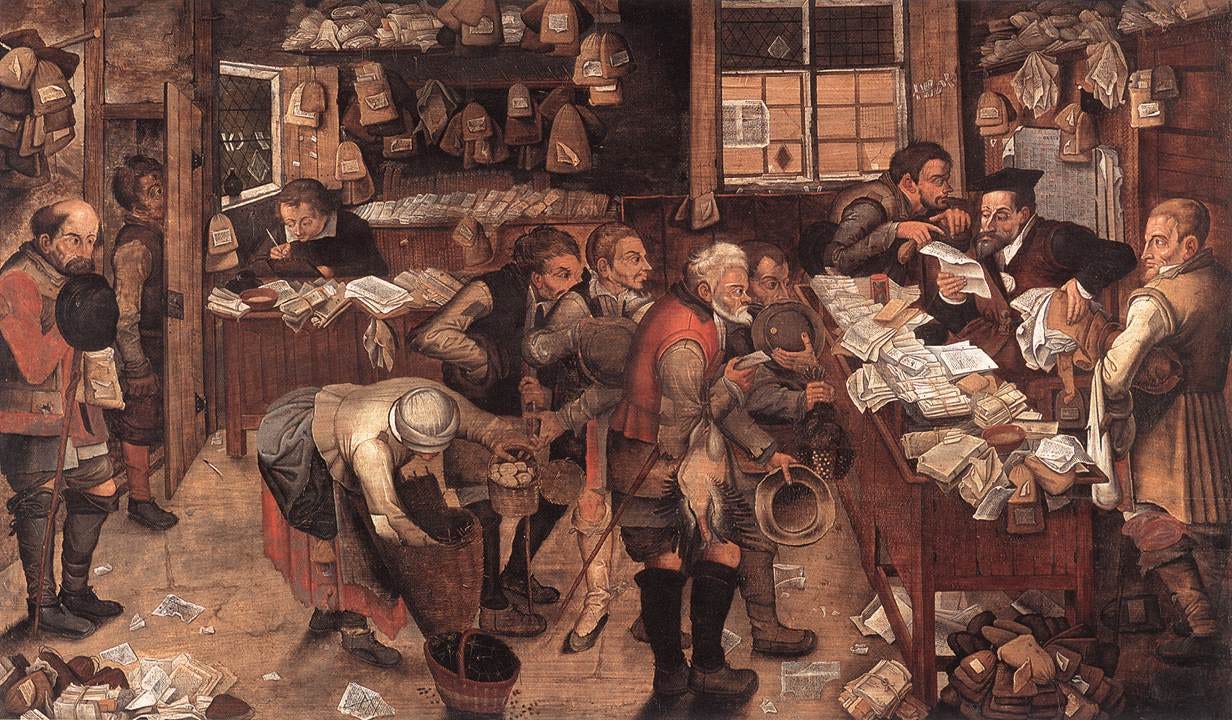Pieter Breughel the Younger, The Village Lawyer, ca. 1621, Museum of Fine Arts, Ghent.
Is it possible to be simultaneously astonished and yet also unsurprised? I can report that it is, for I felt exactly that odd combination of sensations while reading Ross Douthat’s recent account of the “Post-Protestant Gnosticism” that currently dominates the American public sphere, a regime that Douthat describes as the “new hegemon.” Here is the core of the account; I have italicized passages on which I will focus.
Crucially, the ascendant gnosticism influences society in something close to [Jacques] Maritain’s model. It wields its power primarily through the cultural influence of nonpolitical institutions, and only secondarily through direct lawmaking or rulemaking. Its rule is firm within its own institutional territory but more limited and moderated in the political sphere writ large. Where it directly shapes the interpretation of laws, it does so through “vivifying inspiration” rather than ecclesial imposition. Gnostic values pervade the key rulings of a figure such as Anthony Kennedy, for instance, without there having been some explicit gnostic religious edict that the Catholic Kennedy was bound to follow. Likewise, there has been no central committee of wokeness, no progressive Holy Office, driving the rolling reinterpretation of the Civil Rights Act.
At the same time, the new hegemon is tolerant of religious difference, allowing conservative forms of Christianity to persist in the same way the old Christian establishment allowed America’s various heresies to flourish. It simply sets certain limits on their freedom…
What is bewildering here, even disorienting, is the suggestion that the gnostic regime governs primarily through “cultural influence” rather than the coercive instruments of the law. That view is entirely unmoored from the verifiable facts of legal and political life in the United States over the past decade or so. Indeed, as I explain shortly, it is entirely unmoored from the verifiable facts of legal and political life in the United States over the past week or so. It has been acutely observed that liberalism generates “white legends” about its own respect for the autonomy of the governed, while generating “black legends” about the inherently coercive, indeed authoritarian, nature of competing political regimes. But here we have the strange spectacle of a white legend generated by a Catholic commentator on behalf of a gnostic regime, explicitly said to have attained hegemonic status.
Yet on another level the suggestion is entirely unsurprising. It seems to stem from a misconception, common among non-lawyers, about how law works — a misconception rooted in ignorance of the variety of legal instruments a governing regime can use to pressure, hamper, and limit views or groups it disfavors. The non-lawyer’s conception of legal “coercion” is typically based on a misleading paradigm, the direct application of violence. In fact coercion is a spectrum, not an on-off switch, and the law uses a large and diverse set of tools to induce behavior desired by those who wield the tools. Sending agents of the state with guns to enforce orders is rarely how the law proceeds, and in some sense represents a failure of the system, a confession that the use of the other tools was insufficiently artful. At the same time, the agents-with-guns paradigm causes the nonlawyer to overlook that actual coercion can be effected by a governing regime indirectly as well as directly, through the tacit encouragement of “private” groups wielding coercive force or intimidation tactics against disfavored third parties, whom the regime then more or less deliberately fails to protect, through the selective under-enforcement of law.
Over the past decade or so, at an increasing tempo, all of these instruments of the law, ranging from indirect and subtle forms of pressure to direct coercive lawmaking, have been wielded by the gnostic regime to induce desired behavior on the part of recalcitrant institutions, views and persons in the public sphere. Consider some examples:



